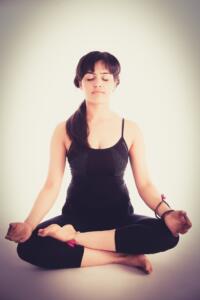Yoga’s origins date back to more than 5,000 years ago in Northern India. Derived from the internalization of ritual sacrifice, yoga teaches practitioners to sacrifice not their bodies, but their egos through wisdom, action and self-knowledge.
Today, modern yoga provides a path to enlightenment, helping those who practice it to cleanse their minds and bodies of negative energy and to disconnect from their physical existence.
Few places provide more opportunity for such enlightenment than the lake, with its natural beauty, picturesque sunsets and hum of wildlife activity.
So take a look at these 5 beginner yoga poses and start enjoying the peace and rejuvenation of this age-old practice.

1. Sukhasana
We start our beginner yoga poses with Sukhasana, also known as the easy pose, which requires practitioners to take a seated position with their legs crossed and folded in front of them.
In this pose, the pelvis should be in a neutral position, in line with the spine.
Palms can be positioned on top of one another in your lap, in a praying position at your chest, or resting on your knees, palms up.
Still seated, find your breath by taking several long, deep breaths in and exhaling them slowly.
After a few moments, you can also start to stretch the neck by slowly bringing chin to chest and as far back as you can comfortably go. Stretch the sides of your neck by bringing your ear to your shoulder, calmly alternating between your left and right sides.
Sukhasana is a good position with which to begin your practice as it helps you find your breath, relaxes the mind, softly stretches your muscles and strengthens your back.
2. Cat/Cow
From the Sukhasana pose, come to all fours with your head hanging loosely and your back in a tabletop position, with your hands in line with your shoulders and your knees in line with your hips.
Next, you will alternately transition in and out of cat/cow, which stretches your torso and neck and brings awareness to your spinal movements.
Cat pose requires practitioners to take a deep breath in, rounding your spine up towards the sky and bringing your chin to your chests. Be mindful that your knees and arms stay firmly in place as your execute your move.
Transition into cow pose by slowly exhaling while pressing your stomach towards the earth and stretching your your chest towards the sky. Direct your gaze forward, so that your head is in line with your shoulders.
Slide in and out of these positions for several deep breaths before coming back to neutral spine.
3. Child’s Pose
Balasana, or child’s pose as it is most-commonly called, is a resting pose that stretches the hips and thighs and helps in relieving fatigue and stress.
To go into child’s pose from cat/cow, bring your big toes together so that your knees press out from your hips. Rock back with your arms extended out in front of you until your bottom rests on the heels of your feet.
Press your chest into the ground so that it rests between your legs. Keep your arms extended, applying slight pressure to your palms.
Take deep, conscious breaths in and out, paying close attention to breathing fully into your chest, stretching your upper spine skyward.
Rest here for as long as you would like, but be sure you are not putting too much strain on your knees or ankles.
4. Downward-Facing Dog
This beginner yoga pose is known by many names: downward dog, downward-facing dog, and (less commonly) Adho Mukha Svanasana.
Downward-facing dog helps improve digestion, relieve mild depression, energizes the body and helps stretch the hands, calves, hamstrings and arches.
To take this position from child’s pose, walk your hands forward, and roll your feet under you. Press into your feet, and extend your legs as you continue walking your hands out until your body creates a triangle with the earth.
Keep your feet hip-width apart and your hands slightly past your shoulders with your fingers spread out to distribute energy evenly between both hands.
In downward dog, you can alternate lifting your heels, press back into your calves, or rock forward gently onto your palms and then back.
5. Mountain Pose
Tadasana, or mountain pose improves posture, strengthens your legs and feet and helps to firm your core and bottom. You can use this pose as a starting or ending position during your practice as it a good resting position for refocusing your breathing.
From downward dog, walk your feet slowly toward your hands until they are directly under your hips. Slowly roll to standing position, paying careful attention to each vertebrae.
When you are fully upright, bring your feet together with your heels slightly apart, softly shifting your weight from foot to foot to gain your balance.
Tighten your core and legs and elongate your spine, keeping sure to align the crown of your head and spine. Bring your awareness to your chest, back and shoulders, so that your energy radiates from the earth through the length of your body.
Open your chest and shoulders bringing your hands, palms facing out, slightly from your sides while pushing your shoulder blades down. Your facial muscles and jaw should be relaxed.
To take your mountain pose to the next level, try closing your eyes.
Hold here while you take deep breaths in and out for about a minute before concluding your practice.
For more tips on beginner yoga poses check out The Yoga Journal, and be sure to check out what other activities you can enjoy around the lake in our article “6 Exercises That Are Better At The Lake.”
Namaste, lake lovers.

